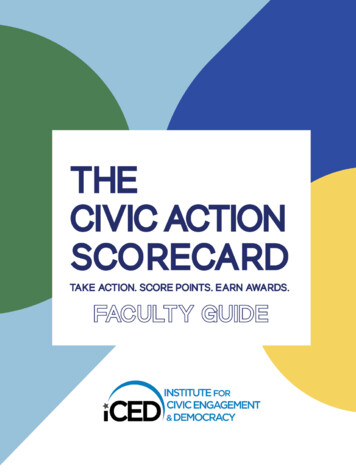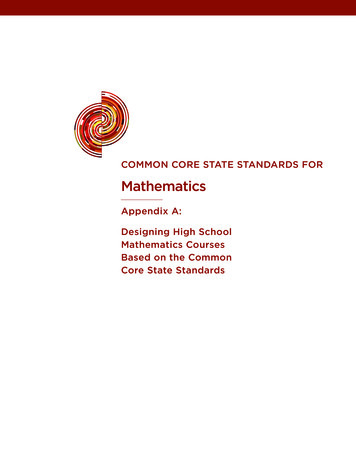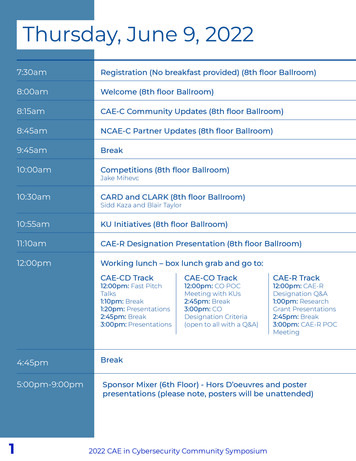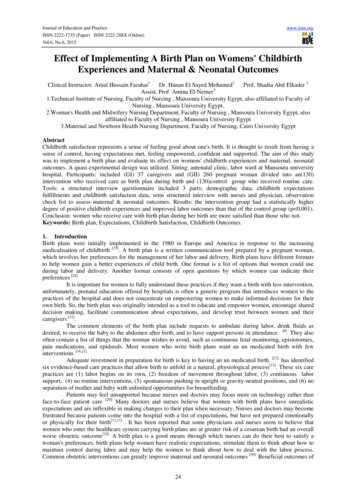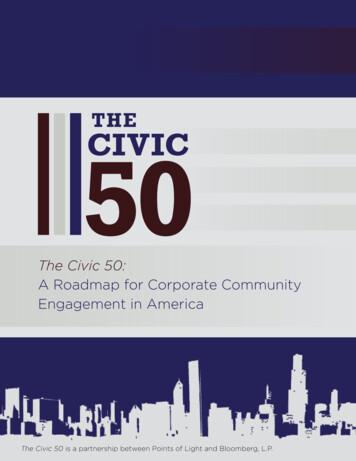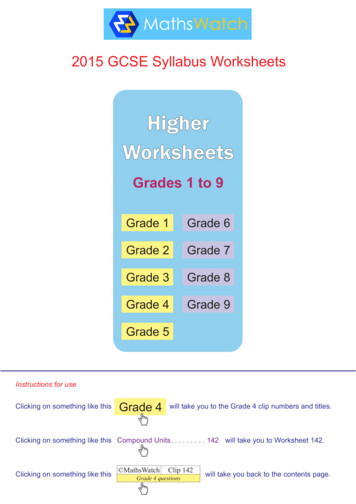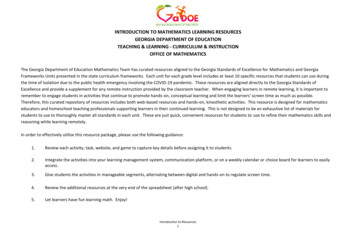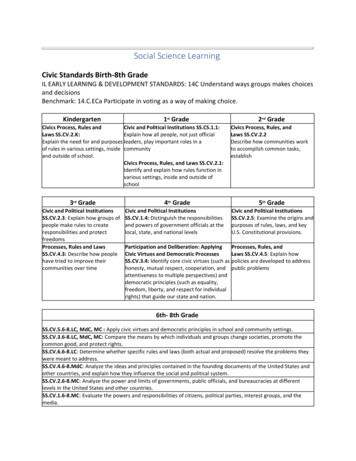
Transcription
Social Science LearningCivic Standards Birth-8th GradeIL EARLY LEARNING & DEVELOPMENT STANDARDS: 14C Understand ways groups makes choicesand decisionsBenchmark: 14.C.ECa Participate in voting as a way of making choice.Kindergarten1st GradeCivics Process, Rules andCivic and Political Institutions SS.CS.1.1:Laws SS.CV.2.K:Explain how all people, not just officialExplain the need for and purposes leaders, play important roles in aof rules in various settings, inside communityand outside of school.Civics Process, Rules, and Laws SS.CV.2.1:Identify and explain how rules function invarious settings, inside and outside ofschool3rd GradeCivic and Political InstitutionsSS.CV.2.3: Explain how groups ofpeople make rules to createresponsibilities and protectfreedomsProcesses, Rules and LawsSS.CV.4.3: Describe how peoplehave tried to improve theircommunities over time4th GradeCivic and Political InstitutionsSS.CV.1.4: Distinguish the responsibilitiesand powers of government officials at thelocal, state, and national levels2nd GradeCivics Process, Rules, andLaws SS.CV.2.2Describe how communities workto accomplish common tasks,establish5th GradeCivic and Political InstitutionsSS.CV.2.5: Examine the origins andpurposes of rules, laws, and keyU.S. Constitutional provisions.Participation and Deliberation: ApplyingProcesses, Rules, andCivic Virtues and Democratic ProcessesLaws SS.CV.4.5: Explain howSS.CV.3.4: Identify core civic virtues (such as policies are developed to addresshonesty, mutual respect, cooperation, and public problemsattentiveness to multiple perspectives) anddemocratic principles (such as equality,freedom, liberty, and respect for individualrights) that guide our state and nation.6th- 8th GradeSS.CV.5.6-8.LC, MdC, MC : Apply civic virtues and democratic principles in school and community settings.SS.CV.3.6-8.LC, MdC, MC: Compare the means by which individuals and groups change societies, promote thecommon good, and protect rights.SS.CV.6.6-8.LC: Determine whether specific rules and laws (both actual and proposed) resolve the problems theywere meant to address.SS.CV.4.6-8.MdC: Analyze the ideas and principles contained in the founding documents of the United States andother countries, and explain how they influence the social and political system.SS.CV.2.6-8.MC: Analyze the power and limits of governments, public officials, and bureaucracies at differentlevels in the United States and other countries.SS.CV.1.6-8.MC: Evaluate the powers and responsibilities of citizens, political parties, interest groups, and themedia.
SS.CV.4.6-8.LC: Explain the connection between interests and perspectives, civic virtues, and democratic principleswhen addressing issues in government and society.SS.CV.6.6-8.MdC; Analyze the purposes, implementation, and consequences of public policies in historic andcontemporary settingsK-8th Inquiry SkillsDeveloping Questions and Planning InquiriesK-2nd Grade3-5th Grade6-8th GradeCreating Essential QuestionsSS.IS.1.K-2: Create questions toSS.IS.1.3-5. Develop essential questions SS.IS.6-8.help guide inquiry about a topic and explain the importance of theCreate essential questions towith guidance from adultsand/or peersquestions to self and others.Begins in 3rd gradeSS.IS.2.3.5. Create supporting question to SS.IS.2.6-8. Ask essential andhelp answer essential questions in anfocusing questions that will lead toinquiryindependent researchSS.IS.2.K-2: Explore facts fromvarious sources that can be usedto answer thedeveloped questionsSS.IS.3.3.5. Determine sourcesrepresenting multiple points of view thatwill assist inanswering essential questions.help guide inquiry about a topicCreating Supporting QuestionsDetermining Helpful SourcesSS.IS.3.6-8. Determine sourcesrepresenting multiple points of viewthat will assist in organizing aresearch plan.Evaluating Sources and Using EvidenceK-2th Grade3-5th GradeGathering and Evaluating SourcesSS.IS.3.K-2: Gather information SS.IS.4.3-5. Gather relevant informationfrom one or two sources withand distinguish among fact and opinion toguidance and support fromdetermine credibility of multiple sources.adults and/or peers.6-8th GradeSS.IS.4.6-8.L.C. Determine the valueof sources by evaluating theirrelevance and intended use.SS.IS.4.6-8.Md.C. Determinecredibility of sources based upontheir origin, authority, and context.SS.IS.4.6-8.MC. Gather relevantinformation from credible sourcesand determine whether theysupport each other.Developing Claims and Using EvidenceSS.IS.4.K-2 Evaluate a sources by SS.IS.5.3.5. Develop claims using evidence SS.IS.5.6-8.L.C. Appropriately cite alldistinguishing between factfrom multiple sources tosources utilized.and opinionSS.IS.5.6-8.MdC.Identify evidenceanswer essential questionsfrom multiple sources to supportclaims, noting its limitations.SS.IS.5-6.8.MC. Develop claims andcounterclaims while pointing out thestrengths and limitations of both.Communicating Conclusion and Taking Informed Action
K-2nd Grade3-5th GradeCommunicating Conclusions6-8th GradeSS.IS.5.K-2: Ask and answerquestions about arguments andexplanations.SS.IS.6.3.5. Construct and critiquearguments and explanations usingreasoning, examples, and details frommultiple sources.SS.IS.6.6-8LC. Construct argumentsusing claims and evidence frommultiple sources, whileacknowledging their strengths andlimitations.SS.IS.6.6-8 MdC. Constructexplanations using reasoning,correct sequence, examples, anddetails, while acknowledging theirstrengths and weaknesses.SS.IS.6.6-8 MC. Present argumentsand explanations that would appealto audiences and venues outsidethe classroom using a variety ofmedia.Begins in 3-5SS.IS.7.3.5. Identify a range of localSS.IS.7.6-8. Critique the structureproblems and some ways in which people and credibility of arguments andare trying to address these problemsexplanations (self and others).SS.IS. 6.K-12 Use listening,consensus building, and votingprocedures to decide on and takeaction in their classrooms.SS.IS.8.3.3-5. Use listening, consensusbuilding, and voting procedures to decideon and take action in their classroomsand school.Critiquing ConclusionsTaking Informed ActionSS.IS.8.6-8.L.C. Analyze how aproblem can manifest itself and thechallenges and opportunities facedby those trying to address it.SS.IS.8.6-8.MdC. Assess individualand collective capacities to takeaction to address problems andidentify potential outcomes.SS.IS.8.6-8 MC. Apply a range ofdeliberative and democraticprocedures to make decisionsand take action in schools andcommunity contexts.Economics and Personal Finance Standards Birth-8th GradeIL EARLY LEARNING & DEVELOPMENT STANDARDS: Explore roles in the economic systemand workforceBenchmarks: 15.A.ECa- Describe some common jobs and what is needed to perform those jobs;15.A.ECb-Discuss why people workKindergarten1st Grade2nd GradeEconomic DecisionMaking SS.EC.2.1: Describe the skillsand knowledge required to producecertain goods and servicesFinancial Literacy SS.EC.FL4.2: Explainthat money can be saved or spent ongoods and services
3rd Grade4th Grade5th GradeExchange and Markets SS.EC.Financial LiteracyNational and Global Economy2.3: Generate examples of the goods SS.EC.FL.3.4: Analyze how spending SS.EC.3.5: Determine the ways inand services that governmentschoices are influenced by price as well which the government pays for theprovide.as many other factors (e.g. advertising, goods and services it provides.peer pressure, options).Financial LiteracyExchange and Markets SS.EC.Exchange and MarketsSS.EC.FL.3.3: Describe the role of2.4: Describe how goods and services SS.EC.1.5: Analyze why and howbanks and other financial institutions are produced using human, natural, individuals, businesses, and nationsin an economy.and capital resources (e.g. tools and around the world specialize andmachines).trade.6th- 8th GradeSS.EC.1.6-8.LC: Explain how economic decisions affect the wellbeing of individuals, businesses and societySS.EC.2.6-8.MdC: Describe the roles of institutions, such as corporations, non-profits, and labor unions in a marketeconomy.SS.EC.3.6-8.MC: Evaluate employment, unemployment, inflation, total production, income and economic growthdata and how they affect different groups.SS.EC.2.6-8.MC: Explain how changes in supply and demand cause changes in prices and quantities of goods andservices, labor, credit, and foreign currenciesSS.EC.FL.2.6-8.LC: Explain the roles and relationships between savers, borrowers, interest, time, and the purposesfor saving.SS.EC.FL.1.6-8.LC: Analyze the relationship between skills, education, jobs, and income.SS.EC.3.6-8.MdC: Explain barriers to trade and how those barriers influence trade among nations.Geography Standards Birth-8th GradeIL EARLY LEARNING & DEVELOPMENT STANDARDS: 17A Explore environment and wherepeople liveBenchmarks: 17.A.ECa- Locate objects and places in familiar environments; 17.A.ECb- Expressbeginning geographic thinking.Kindergarten1st Grade2nd GradeHuman-Environment InteractionsSS.G.1.K: Explain how weather,climate, and other environmentalcharacteristics affect people’s livesGeographicalRepresentations SS.G.1.1:Construct and interpret maps andother representations to navigate to afamiliar placeGeographicalRepresentations SS.G.1.2:Construct and interpret maps andother graphic representations of bothfamiliar and unfamiliar placesHuman Environment Interaction SS.G.2.2Identify some cultural andenvironmental characteristics of yourcommunity and compare to otherplaces3rd Grade4th Grade5th Grade
Human-Environment Interaction:Place, Regions, and CultureSS.G.2.3: Compare how peoplemodify and adapt to the environmentand culture in our community toother places.Geographic Representations: SpatialViews of the World SS.G.1.3: Locatemajor landforms and bodies of wateron a map or other representation.Geographic Representations: SpatialViews of the World SS.G.1.4:Construct and interpret maps ofIllinois and the United States usingvarious media.Human-Environment Interaction:Place, Regions, and Culture SS.G.1.5:Investigate how the cultural andenvironmental characteristics ofplaces within the United Stateschange over time.Human Population: Spatial Patterns Global Interconnections: Changingand Movements SS.G.3.4: Describe Spatial Patterns SS.G.4.5: Comparesome of the current movements of the environmental characteristics ofgoods, people, jobs, or information the United States to other worldto, from, or within Illinois, and explain regions.reasons for the movements.6th - 8th GradeSS.G.3.6-8.LC: Explain how environmental characteristics impact human migration and settlement.SS.G.2.6-8.LC: Explain how humans and their environment affect one another.SS.G.4.6-8.MdC: Explain how global changes in population distribution patterns affect changes in land use.SS.G3.6-8.MdC: Explain how changes in transportation and communication influence the spatial connectionsamong human settlements and affect the spread of ideas and culture.SS.G3.6-8.MC: Evaluate the influences of long-term human induced environmental change on spatial patterns ofconflict and cooperation.SS.G2.6-8.MC: Evaluate how cultural and economic decisions influence environments and the daily lives of peoplein both nearby and distant places.History Standards Birth-8th GradeIL EARLY LEARNING & DEVELOPMENT STANDARDS: 18B Develop an awareness of self within thecontext of the familyBenchmark: 18.B ECa- Understand that each of us belongs to a family and recognize thatfamilies varyKindergarten1st Grade2nd GradeChange, Continuity, and ContextChange, Continuity, andSS.H.1.K: Compare life in the past to Context SS.H.2.1: Describe individualslife todayand groups who have shaped asignificant historical changePerspectives SS.H.3.1: Compareperspectives of people in the past tothose of people in the presentChange, Continuity, andContext SS.H.1.2:Summarize changes that haveoccurred in the local community overtimePerspectives SS.H.2.2:Compare individuals and groups whohave shaped a significant historicalchange3rd4th Grade5th GradePerspectives SS.H.2.3: Describe howsignificant people, events, anddevelopments have shaped their owncommunity and region.Perspectives SS.H.1.4: Explainconnections among historicalcontexts and why individuals andgroups differed in their perspectivesduring the same historical period.Historical Sources and EvidenceSS.H.2.5: Use information about ahistorical source-including the maker,date, place of origin, intendedaudience, and purpose-to judge the
Historical Sources and EvidenceSS.H.3.3: Identify artifacts anddocuments as either primary orsecondary sources of historical datafrom which historical accounts areconstructed.extent to which the source is usefulfor studying a particular topic.Causation and ArgumentationCausation and ArgumentationSS.H.3.4: Explain probable causes and SS.H.3.5: Explain probable causes andeffects of events and developments effects of events and developmentsin Illinois historyin U.S. history.6-8 GradeSS.H.2.6-8.LC: Explain how and why perspectives of people have changed over time.SS.H.4.6-8.LC: Explain multiple causes and effects of historical events.SS.H.1.6-8.MdC: Analyze connections among events and developments in broader historical contexts.SS.H.2.6-8.MdC: Analyze multiple factors that influenced the perspectives of people during different historicaleras.SS.H.2.6-8.MC: Analyze how people’s perspectives influenced what information is available in the historicalsources they createdSS.H.4.6-8.MC: Organize applicable evidence into a coherent argument about the past.Social Science Learning: High SchoolInquiryConstructing Essential Questions SS.IS.1.912: Address essential questions that reflect an enduring issuein the field.Constructing Supporting Questions SS.IS.2.9-12: Explain howsupporting questions contribute to an inquiry.Determining Helpful Sources SS.IS.3.9-12: Developnew supporting and essential questions through investigation,collaboration, and using diverse sources.Gathering and Evaluating Sources SS.IS.4.9-12: Gather andevaluate information from multiple sources while consideringDeveloping Claims and Using Evidence SS.IS.5.9the origin, credibility, point of view, authority, structure,12: Identify evidence that draws informationcontext, and corroborative value of the sources.from multiple sources to revise or strengthenclaims.Communicating Conclusions SS.IS.6.9-12. Construct andevaluate explanations and arguments using multiple sources andrelevant, verified information.Critiquing Conclusions SS.IS.7.9-12. Articulate explanations andarguments to a targeted audience in diverse settings.Taking Informed Action SS.IS.8.9-12. Use interdisciplinary lensesto analyze the causes and effects of and identify solutions tolocal, regional, or global concerns.Taking Informed Action SS.IS.9.9-12. Use deliberative processesand apply democratic strategies and procedures to address
local, regional or global concerns and take action in or out ofschool.CivicsSS.CV.1.9-12. Distinguish the rights, roles, powers, and responsibilities of individuals and institutions in thepolitical system.SS.CV.3.9-12. Analyze the impact of constitutions, laws, and agreements on the maintenance of order, justice,equality, and liberty.SS.CV.4.9-12. Explain how the U.S. Constitution established a system of government that has powers,responsibilities, and limits that have changed over time and are still contested while promoting the common goodand protecting rights.SS.CV.5.9-12. Analyze the impact of personal interest and diverse perspectives on the application of civicdispositions, democratic principles, constitutional rights, and human rights.SS.CV.6.9-12: Describe how political parties, the media, and public interest groups both influence and reflect socialand political interests.SS.CV.8.9-12: Analyze how individuals use and challenge laws to address a variety of public issues.SS.CV.9.9-12: Evaluate public policies in terms of intended and unintended outcomes and related consequences.EconomicsSS.EC.1.9-12: Analyze how scarcity and incentives influence choices to consume or produce for differentindividuals and groups.SS.EC.4.9-12: Evaluate the effectiveness of government policies to improve market outcomes, address inequality,or reduce inefficiencies.SS.EC.6.9-12: Use data and economic indicators to analyze past and current states of the economy and predictfuture trends.SS.EC.7.9-12: Describe how government policies are influenced by and impact a variety of stakeholders.SS.EC.8.9-12: Analyze how advances in technology and investment in capital goods and human capital affecteconomic growth and standards of living.SS.EC.10.9-12: Explain how globalization trends and policies affect social, political, and economic conditions indifferent nations.Financial LiteracySS.EC.FL.2.9-12: Explain how to make informed financial decisions by collecting information, planning, andbudgeting.SS.EC.FL.3.9-12: Explain how time, interest rates, and inflation influence saving patterns over a lifetime.SS.EC.FL.4.9-12: Analyze costs and benefits of different credit and payment options for goods and services, therole of lenders, and interest.SS.EC.FL.5.9-12: Evaluate the risk and returns on diversified investments.GeographySS.G.1.9-12: Use maps (created using geospatial and related technologies, if possible), satellite images, andphotographs to display and explain the spatial patterns of physical, cultural, political, economic, andenvironmental characteristics.
SS.G.2.9-12: Use self collected or pre-existing data sets to generate spatial patterns at multiple scales that can beused to conduct analyses or to take civic action.SS.G.3.9-12: Analyze and explain how humans impact and interact with the environment and vice versa.SS.G.4.9-12: Evaluate how political and economic decisions have influenced cultural and environmentalcharacteristics of various places and regions.SS.G.8.9-12: Evaluate how short- and long-term climate variability impacts human migration and settlementpatterns, resource use, and land uses.SS.G.9.9-12: Describe and explain the characteristics that constitute a particular culture.SS.G.11.9-12: Explain how globalization impacts the cultural, political, economic, and environment characteristicsof a place or region.HistorySS.H.1.9-12: Evaluate how historical developmentswere shaped by time and place as well as broaderhistorical context.SS.H.2.9-12: Analyze change and continuity within andacross historical eras.SS.H.7.9-12: Identify the role of individuals, groups,and institutions in people's struggle for safety,SS.H.8.9-12: Analyze key historical events andfreedom, equality, and justice.contributions of individuals through a variety ofSS.H.9.9-12: Analyze the relationship betweenperspectives, including those of historically underhistorical sources and the secondary interpretations represented groups.made from them.SS.H.11.9-12: Analyze multiple and complex causesand effects of events in the past.AnthropologySS.Anth.1.9-12: Analyze the elements of culture and explain the factors that shape these elements differentlyaround the world.SS.Anth.1.9-13: Explain how cultures develop and vary in response to their physical and social environment,including local, national, regional, and global patterns.SS.Anth.1.9-14: Explain why anthropologists study culture from a holistic perspective.SS.Anth.4.9-12: Evaluate one's own cultural assumptions using anthropological concepts.SS.Anth.5.9-12: Apply anthropological concepts and anthropological knowledge to a variety of everyday, realworld situations.SS.Anth.6.9-12: Explain how local actions can have global consequences, and how global patterns and processescan affect seemingly unrelated local actions.PsychologySS.Psy.1.9-12: Identify scientific methodologies utilized in psychological research.SS.Psy.2.9-12: Evaluate the conclusions made by psychological research, including ethical concerns.SS.Psy.3.9-12: Understand a variety of psychological perspectives and apply their concepts and theoretical ideas tothe investigation of similarities and differences in behavior and mental processes.
SS.Psy.4.9-12: Analyze how biological, psychological, and sociocultural factors and their interactions influenceindividuals' behavior and mental processes.SS.Psy.5.9-12: Evaluate the complexities of human thought and behavior, as well as the factors related to theindividual differences among people.SS.Psy.6.9-12: Identify and apply psychological thinking to personal and societal experiences and issues.SS.Psy.7.9-12: Apply psychological knowledge to their daily lives.SS.Psy.8.9-12: Use appropriate psychological terminology with reference to psychologists, their experiments, andtheories in order to explain the possible causes of and impact on behavior and mental processes.SociologySS.Soc.1.9-12: Identify and apply the sociological perspective and a variety of sociological theories.SS.Soc.2.9-12: Analyze the impact of social structure, including culture, institutions, and societies.SS.Soc.3.9-12: Hypothesize how primary agents of socialization influence the individual.SS.Soc.4.9-12: Describe the impact of social relationships on the self, groups, and socialization processesSS.Soc.5.9-12: Explain the social construction of self and groups and their impact on the life chances ofindividuals.SS.Soc.6.9-12: Analyze the impact of stratification and inequality on groups and the individuals within them.
Views of the World SS.G.1.3: Locate major landforms and bodies of water on a map or other representation. Human Population: Spatial Patterns and Movements SS.G.3.4: Describe some of the current movements of goods, people, jobs, or information to, from, or within Illinois, and explain reasons for the movements. Global Interconnections: Changing
